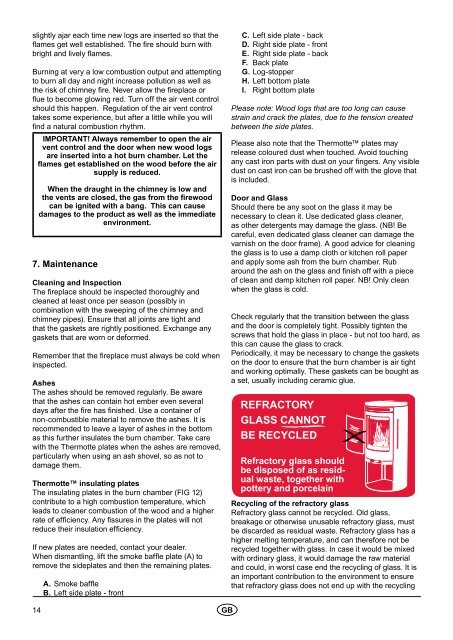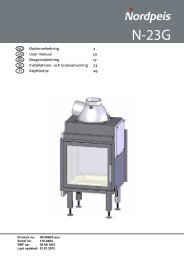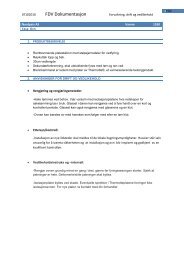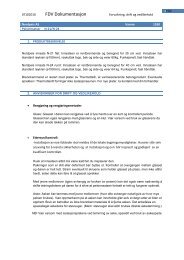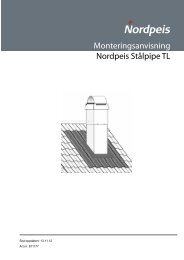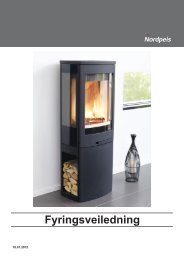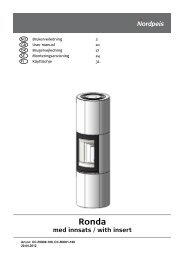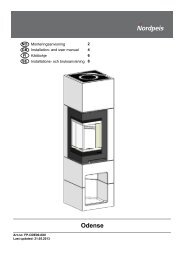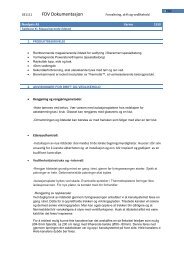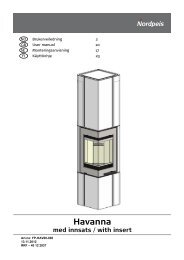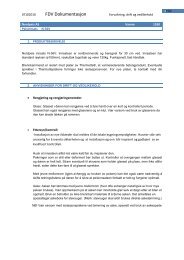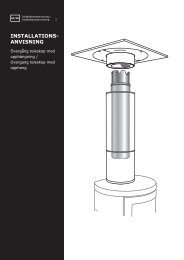Monteringsanvisning Ronda 160 - Nordpeis
Monteringsanvisning Ronda 160 - Nordpeis
Monteringsanvisning Ronda 160 - Nordpeis
- No tags were found...
You also want an ePaper? Increase the reach of your titles
YUMPU automatically turns print PDFs into web optimized ePapers that Google loves.
slightly ajar each time new logs are inserted so that theflames get well established. The fire should burn withbright and lively flames.Burning at very a low combustion output and attemptingto burn all day and night increase pollution as well asthe risk of chimney fire. Never allow the fireplace orflue to become glowing red. Turn off the air vent controlshould this happen. Regulation of the air vent controltakes some experience, but after a little while you willfind a natural combustion rhythm.IMPORTANT! Always remember to open the airvent control and the door when new wood logsare inserted into a hot burn chamber. Let theflames get established on the wood before the airsupply is reduced.When the draught in the chimney is low andthe vents are closed, the gas from the firewoodcan be ignited with a bang. This can causedamages to the product as well as the immediateenvironment.7. MaintenanceCleaning and InspectionThe fireplace should be inspected thoroughly andcleaned at least once per season (possibly incombination with the sweeping of the chimney andchimney pipes). Ensure that all joints are tight andthat the gaskets are rightly positioned. Exchange anygaskets that are worn or deformed.Remember that the fireplace must always be cold wheninspected.AshesThe ashes should be removed regularly. Be awarethat the ashes can contain hot ember even severaldays after the fire has finished. Use a container ofnon-combustible material to remove the ashes. It isrecommended to leave a layer of ashes in the bottomas this further insulates the burn chamber. Take carewith the Thermotte plates when the ashes are removed,particularly when using an ash shovel, so as not todamage them.Thermotte insulating platesThe insulating plates in the burn chamber (FIG 12)contribute to a high combustion temperature, whichleads to cleaner combustion of the wood and a higherrate of efficiency. Any fissures in the plates will notreduce their insulation efficiency.If new plates are needed, contact your dealer.When dismantling, lift the smoke baffle plate (A) toremove the sideplates and then the remaining plates.A. Smoke baffleB. Left side plate - frontC. Left side plate - backD. Right side plate - frontE. Right side plate - backF. Back plateG. Log-stopperH. Left bottom plateI. Right bottom platePlease note: Wood logs that are too long can causestrain and crack the plates, due to the tension createdbetween the side plates.Please also note that the Thermotte plates mayrelease coloured dust when touched. Avoid touchingany cast iron parts with dust on your fingers. Any visibledust on cast iron can be brushed off with the glove thatis included.Door and GlassShould there be any soot on the glass it may benecessary to clean it. Use dedicated glass cleaner,as other detergents may damage the glass. (NB! Becareful, even dedicated glass cleaner can damage thevarnish on the door frame). A good advice for cleaningthe glass is to use a damp cloth or kitchen roll paperand apply some ash from the burn chamber. Rubaround the ash on the glass and finish off with a pieceof clean and damp kitchen roll paper. NB! Only cleanwhen the glass is cold.Check regularly that the transition between the glassand the door is completely tight. Possibly tighten thescrews that hold the glass in place - but not too hard, asthis can cause the glass to crack.Periodically, it may be necessary to change the gasketson the door to ensure that the burn chamber is air tightand working optimally. These gaskets can be bought asa set, usually including ceramic glue.REFRACTORYGLASS CANNOTBE RECYCLEDRefractory glass shouldbe disposed of as residualwaste, together withpottery and porcelainRecycling of the refractory glassRefractory glass cannot be recycled. Old glass,breakage or otherwise unusable refractory glass, mustbe discarded as residual waste. Refractory glass has ahigher melting temperature, and can therefore not berecycled together with glass. In case it would be mixedwith ordinary glass, it would damage the raw materialand could, in worst case end the recycling of glass. It isan important contribution to the environment to ensurethat refractory glass does not end up with the recycling14 GB


